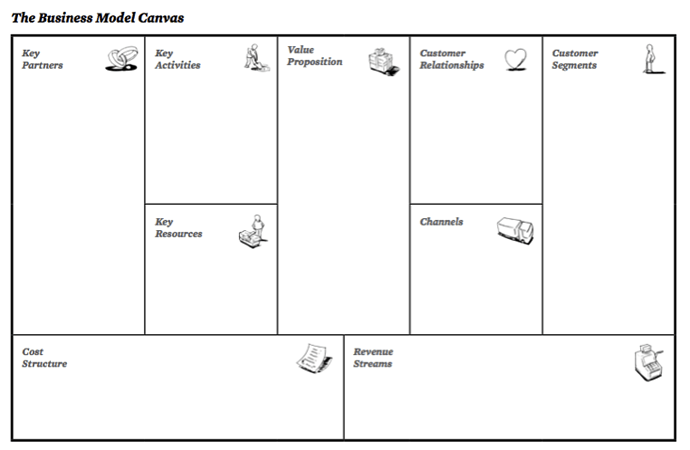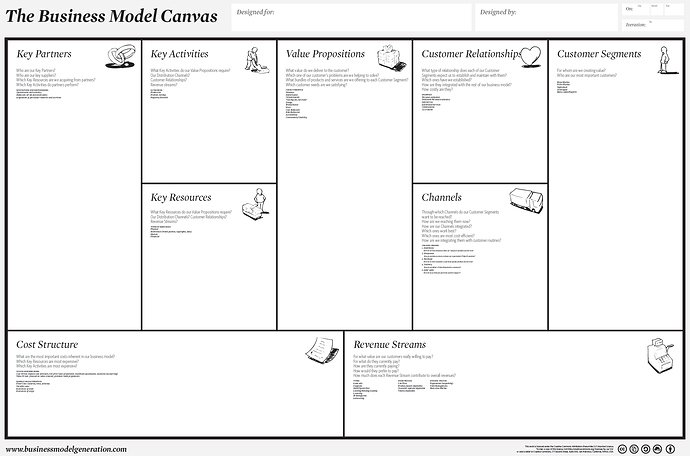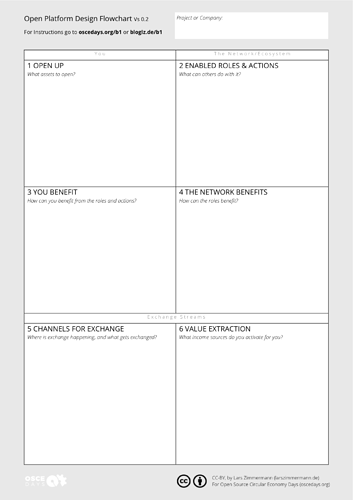#SCRIPT Dev.
##Setting Of The Video
Sitting on a desk with a laptop infront of me. I will read the text.
Next to me a card with the URL where people can find (this) a topic with the full script, the tool, and links – like material they can follow while listening to the video.
The video will not be edited. Everything in one shot.
During the video I will pick some more cards with bullet points and also some objects to show.
STUFF TO PUT ON TABLE
- MP3 Player or other small device running Linux
- Dinosaur Figure
- Matroschka
- A card with the URL to the Script
- A Board with different cards when the tool part starts
- An Arduino
#INTRO
Hi,
I am Lars, Lars Zimmermann. I am an Artist & Economist. And one of the founders of the Open Source Circular Economy Days.
This is a Video about Open Source Business Models for Circular Economy – which is one questions of Open Source Circular Economy Days.
What is the Open Source Circular Economy Days? The Open Source Circular Economy Days – or in short OSCEdays – is a global community, event and organisation to support the building of a sustainable circular economy by using and exploring the collaboration methodology of Open Source.
For this video you can find several resources like the full script, images, links and a tool I will talk about by following one of this links:
Pointing to a Card staying next to me with two URLS oscedays.org/b1 and bloglz.de/b1 (On Both URLS there will be a link to the forum topic where the Video will be embedded.
Ok. Let’s start.
–
#OSCEdays CORE Question & Idea
Part One: What is the Core-Idea of the Open Source Circular Economy Days?
When we talk about a Circular Economy we are talking about the idea of an economy that does not produce any waste! Because everything is designed and organized in a way that our products can be repaired, reused, refurbished and if all of this is not working anymore fully recycled – so that the materials can be won back 100% for new products of the same quality. The circular economy is an economy works in productive and evolving symbiosis with our bioshpere – constantly growing each others potentials.
When we look at this idea and compare it to our current world it quickly becomes clear that almost everything in our current economy has to change for this. Not just the designs of the products but also the collaboration methods we use to make them and distribute them.
Many people in Circular Economy often talk a lot about “transparency”. We would need a lot more transparency to make our economy circular.
But the next thing is people start to talk about trading secrets and the need to hide knowledge from competitors.
And here is where Open Source comes in!
Because in Open Source there is a lot of transparency. But also a number of successful businesses and products! Many are successful not DESPITE but BECAUSE they are open, and transparent. What can we adapt from this to create successful circular economy businesses?
#OPEN SOURCE
Part Two: What Is Open Source?
Sam Muirhead and I did a video on this last year [LINK].
And to sum it up: It basically means that have your “Building Plans” in the public. It is openly visible for others how things work and how you make them work. And all of is shared in such a way that ti allows others to study, use, modify and distribute it – also commercially. Meaning you provide it under licenses and in formats that enables others to do all this.
In the world of Software Open Source is very successful, in many areas. And areas outside of software are also catching up.
There are a lot of people, there is a clear Definition [LINK] and a good number of working business models and business cases.
There is a number of misconceptions out there about Open Source. Like it is all DIY – Do It Yourself – or Everything Is For Free! But in software Open Source is foremost a collaboration method between experts and highly specialized professionals. And it really made and makes a difference in the world.
The Open Source Software Linux is probably the most important and most used software in todays world. Wherever you are watching this right now it is pretty likely that very close to you is one or more devices running Linux.
Like here or here.
Put my Android Phone and an MP3 Player on the Table
The whole web is based in its critical infrastructure on Open Source and also big companies with incredibly sophisticated software solutions like Facebook would not be possible in that dimension without Open Source. There is Open Source everywhere in Facebook.
So without Open Source the web would probably be where it was . . . I don’t know, ten years ago.
Can we take this methodology to enable the building of a Circular Economy? Make quicker progress here? Or enable the Circular Economy at all?
That is our question. That is what the OSCEdays are here to figure out.
#BUSINESS MODELS
Part Three: The Business Models
Yes, the Business Models. Bringing Open Source to new areas is often not trivial. We need to be very creative!
And understanding Open Business Models is not what we all learned in school or are teached around every corner in today’s world.
So with this Video I like to share a little bit of my perspectives on Open Source Business Models.
The goal of this video is not to give an exhaustive Overview. My hope is that it will seed some ideas and clues in your head, enable you to engage in your own creative process, and find an open business model.
#NOT ALL NEEDS TO BE OPEN SOURCE – ONLY THE PARTS NECESSARY FOR CIRCULARITY
The first idea or clue I’d like to share is, that you maybe don’t need to make everything Open Source!
Not even in the world of software everything is open source. People write Open Source software using closed languages for example.
And let’s say you are building a piece of furniture that is Open Source like a desk where the plan is open. You will still use wood and nuts and bolts that are most probably not from a factory that works open source. But everyone can see that you are using the wood and can find out where to get similar wood to get started with an own table.
And here in our context of the Open Source Circular Economy Community the question is always:
###What parts of the product or process needs to be Open Source to enable circularity?
Picks Dinosaur from under the table
[DINOSAUR]
I have here this dinosaur but imagine I would hold an action-figure of Superman in my hand. And imagine the superman would be made from a fully recyclable material – this material, that fact that it is used here and the way how to proper recycle it should be open source! That will make the recycling much more likely. The Material.
But the shape and the character of Superman would still be owned by Warner/DC. It does not need to be open to make the circularity of the action figure work!
And this may be a good time to mention, that in Open Source brands are still protected. Brands are as strong as everywhere. Because if the Building Plan of something is open it matters even more who actually produces the device, piece of clothing or whatever. How careful, with what skills, materials, ethical standards and so on. How good is the quality of the actual physical thing?
[MATROSCHKA]
Picks a Matroschka From Under The Table
If you have a fantastic machine in your factory that is able to draw a beautiful face on this Matroschka in under a second – this process does not necessarily need to be open source. But make sure it is open source how people can wash away the ink, reuse, recycle or biodegrade it. And that the ink itself is Open Source so others can use it. And a recycler can collect a big pile of parts with that ink on them before he turns on the actual process of recycling.
The best case scenario is that you are to use that ink – because it is open source – and you are open about it.
But again, the face of the Matroschka and the maybe sophisticated process you use to paint it on can remain closed and yours – your competitive advantage.
#NOT DESPITE BUT BECAUSE OPEN
The next core Idea I’d like to share is, that you should try to find a way to structure your company, product or project in a way that it is successful not DESPITE but BECAUSE it is open.
This means: If you chose the Open Source road a lot of new possibilities pop up. For example for partnerships, for new products, for innovation and so on. Try to make those work for you.
Open Source is not necessarily a “gift” or “charity” to the world. In Business Open Source is sometimes even used as an “aggressive” strategy for growth!
Google developed Android as Open Source to be able to catch up with Apples Iphone OS ecosystem. Because it was open a lot of people and companies could contribute very easily to it – use it on their phones, create new apps and so on – resulting into an ecosystem with even more apps and so on. And Google could place his Play Store right into the middle of everything.
Android is the most spread computer operating system in the world today. By far!
Tesla Motors made a similar move when they opened up their patents. Because Electric Cars need a huge infrastructure and an ecosystem of chargers and pit stops to work, no company can build this alone. The stronger this ecosystem is the more people will start to think about getting an electric car. The more potential customers Tesla Motors has!
These are just two examples of how a company can be successful BECAUSE they are Open Source!
#PLATFORMS / ECOSYSTEMS
And now I already mentioned the next core idea – which is important: platforms, or ecosystems.
Successful Open Source products often work as platforms. They provide opportunities for other partners to become active. They allow open ecosystems with a lot of other actors like businesses to emerge around the core product. Actors that use the product or add to it. Making it stronger and more useful to the consumers.
There has been a lot written about platforms. And people think that in the future everything that can become a platform will become a platform. Platforms are a fantastic way to collaborate. And openness can be a great driver to build a platform.
I want to give you two examples. One is software, the other is hardware.
I’ll talk about Wordpress and Arduino. If you know them already you can skip the next maybe 4 to 5 minutes of this video I guess. If not, stay with me:
##[Example: WORDPRESS]
The first example is Wordpress. Wordpress is an open source software to create blogs and websites. You can just download the software, install it and you have a basic website online within minutes that you can then customize.
Wordpress is incredibly successful. 24% of all websites today are built with wordpress. 24 %! If you have followed these two links you have been on one.
How could wordpress become so big? Because it is Open Source! There is an incredible rich ecoystem of commercial actors around wordpress constantly growing the system together. If you decide to hire a webdesigner to set up a professional website for you, there is a good chance that this person will set up a wordpress page for you.
The Webdesigner will download the software, install it for you, and because it is open source will be able to make changes to customize the page just for you. And maybe the designer will share the customization as open source with other designers and developers to get feedback, fame, collaborators or whatever.
There are thousands of open source themes and plugins for wordpress everyone can just download, install and run. Creating a powerful, unique and sophisticated website.
Many people and companies are contributing to the system. And with every contribution it becomes stronger and more useful – allows thousands of professional web designers to do their paid job better!
The name of the company behind Wordpress is Automattic. And they make money in a lot of different ways benefiting from the ecosystem: They sell web hosting, support, premium accounts and opportunities, run ads and more. You can find out about it by clicking on the link provided in the resources for this video.
OK. That is a software example. A strong ecosystem that will result in a much better product and better business opportunities for all parties involved.
##[Example: ARDUINO]
Ok, I’d like to give you another example. A hardware example. From electronic hardware.
SHOWING AN ARDUINO
This is an Arduino. A product of an Italian company. And maybe the biggest Open Source Hardware Platform in the world today. It is a microcontroller.
If you are not familiar with electronics let me briefly explain to you what this thing is.
HOLDS ARDUINO INTO THE CAMERA
You have here on one side Inputs where you can plug in all kinds of things like for example a sensor for temperature.
And on the other side you have all kinds of outputs where you can plug in all kinds of actors let’s say a motor with a fan.
The middle part you can program and say stuff like: If the temperature sensor on the right says it is 30 degrees please turn on the motor with the fan on the left side. So you have an air conditioner. But if the heat goes up to 60 degrees please turn off the motor so the air conditioner does not set itself on fire.
A microcontroller you have in every “semi-intelligent” machine in your home – in your washing machine, in you air conditioner, you micro wave and so on.
The difference to all that other microcontrollers is that this one is open source. The hardware is open source. And the software you use to program this thing is open source as well. And the whole thing is very easy to access because it has an USB port.
And the most important thing is that the whole culture established around the Arduino breathes Open Source as well!
If you go to the Arduino website and visit the forum you find over 1 Million entries where people shared solutions and ideas on how to use an Arduino.
People all over the world build all kinds of crazy projects with this: From making plants doing phone calls to satellites in space to electric cars to drones … the list is endless. And many of them share what they are doing openly.
Meaning if you want to build an irrigation system with your Arduino you can go online and find hundreds of projects that already did something similar and you can learn from them, maybe download code and so on. You are much quicker and can do much more interesting things benefiting from this culture.
Hobbyists and Pros are using Arduino. My guess ist that all this “internet of things” start ups today – many of them if not most of them build their first prototypes with an Arduino – benefitting from that open ecosystem, and sometimes contributing to it.
This is one part of the story – software and use cases.
The other part is that a lot of companies are getting involved and providing products to combine with the Arduino. This is very easy through the openness of Arduino.
An example for this are “shields”. A shield is something you can stick on top of the Arduino to give it new powers. A regular Arduino does not have WiFi. But you can buy a shield from another company put it on top of the Arduino and make it have WiFi.
So many people and companies come up with good ideas for the system. Arduino could not do all of this alone.
All this companies have businesses. And they are helping to make Arduino an ever more powerful and useful tool. And Arduino is selling Arduinos. An ever more useful tool.
So here you have a product that really exists and works – also commercially – BECAUSE it is open! The whole difference it makes, the whole product it is – is because it is Open Source.
OK From here on I will dive into the tool (see above). The rest of the script and the tool will follow in the coming days.



